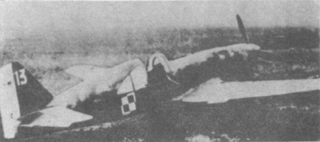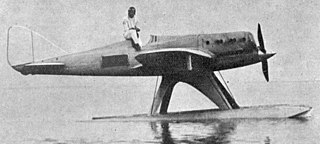Related Research Articles

The Amiot 143 was a 1930s French 5-seat Multiplace de Combat (M.5) designed to meet 1928 specifications for a monoplane capable of day and night bombing, long-range reconnaissance and bomber escort.

The Morane-Saulnier M.S.406 is a French fighter aircraft developed and manufactured by Morane-Saulnier starting in 1938. It was France's most numerous fighter during the Second World War and one of only two French designs to exceed 1,000 in number. At the beginning of the war, it was one of only two French-built aircraft capable of 400 km/h (250 mph) – the other being the Potez 630.

The C.710 were a series of light fighter aircraft developed by Caudron-Renault for the French Air Force just prior to the start of World War II. One version, the C.714, saw limited production, and were assigned to Polish pilots flying in France after the fall of Poland in 1939. A small number was also supplied to Finland.

The Fairey Fox was a British light bomber and fighter biplane of the 1920s and 1930s. It was originally produced in Britain for the RAF, but continued in production and use in Belgium long after it was retired in Britain.

The Latécoère 28 was a long distance monoplane aircraft designed and produced by the French aircraft manufacturer Latécoère.

The Bloch MB.170 and its derivatives were French reconnaissance bombers designed and built shortly before the Second World War. They were the best aircraft of this type available to the Armée de l'Air at the outbreak of the war, with speed, altitude and manoeuvrability that allowed them to evade interception by the German fighters. Although the aircraft could have been in service by 1937, debate over what role to give the aircraft delayed deliveries until 1940.

The Farman F.220 and its derivatives were thick-sectioned, high-winged, four engined French monoplanes from Farman Aviation Works. Based on the push-pull configuration proven by the F.211, design started in August 1925 and the first flight of the prototype was on 26 May 1932. The largest bomber to serve in France between the two world wars was the final F.222 variant. One variation was intended to be an airliner.

Potez 25 was a French twin-seat, single-engine sesquiplane designed during the 1920s. A multi-purpose fighter-bomber, it was designed as a line aircraft and used in a variety of roles, including fighter and escort missions, tactical bombing and reconnaissance missions. In the late 1920s and early 1930s, Potez 25 was the standard multi-purpose aircraft of over 20 air forces, including French and Polish. It was also popular among private operators, notably mail transport companies.

The Arsenal VG 90 was a French carrier-based jet-engined interceptor developed in the late 1940s. It was intended to compete for an Aéronavale contract and first flew in 1949. It set a speed record for a French aircraft the following year, but both of the completed prototypes were destroyed in fatal crashes and the program was cancelled in 1952 before the third prototype was finished. The Aéronavale contract was eventually awarded to a license-built British aircraft. The remains of the last VG 90 were scrapped in 1978.

The Latécoère 521 was a French six-engined double deck flying boat designed and manufactured by Pierre-Georges Latécoère. At the time of its completion, it held the distinction of being the largest aircraft to be built in France as well as one of the first large passenger aircraft capable of flying trans-Atlantic routes.

The Fairey Fantôme, also known as the Fairey Féroce, was a Belgian fighter prototype of the mid-1930s. The prototype was designed and built by Fairey Aviation and three production aircraft were assembled in Belgium by Avions Fairey.

The Dewoitine D.513 was a 1930s prototype French monoplane fighter designed and built by Dewoitine.

The Romano R.90 was a prototype single-seat French floatplane fighter of the 1930s. A single example of the R.90 was built, but the type did form the basis of the Romano R.83 and Romano R.92 fighters which were built in secret for the Spanish Republicans during the Spanish Civil War.
The IAR 13 is a Romanian low-wing monoplane fighter-trainer aircraft designed before World War II.

The Bernard H.V.41 was a racing seaplane designed by Société des Avions Bernard for the French government to compete in the 1929 Schneider Trophy.

The Loire 250 was a French single-seat fighter monoplane designed and built by Loire Aviation of St. Nazaire.
The Arsenal-Delanne 10 was an experimental fighter aircraft of French origin. The plane had a rear cockpit and a distinctive tandem wing.

The Bernard H.V.120 was a racing seaplane designed and built by the French aircraft manufacturer Bernard. It was developed specifically to compete in the Schneider Trophy race.

The Potez-CAMS 161 was a large, French six-engined flying boat airliner, designed to operate on the North Atlantic routes that were opening up in the late 1930s. Its development was almost halted by World War II. Just one was built and partially tested before its destruction by Allied forces near the war's end.
The Charpentier C1 was a French tailless experimental aircraft that was designed by Jean Charpentier during the 1930s. The single prototype crashed on its first flight in January 1934 and further development was cancelled.
References
- ↑ "L'Arsenal de l'aéronautique" (PDF). www.hydroretro.net. 2007-08-18. Retrieved 2011-06-16.
- ↑ Bridgman, Leonard, ed. (1947). Jane's all the World's Aircraft 1947. London: Sampson Low, Marston & Co. pp. 113c –114c.
- ↑ Gaillard, Pierre (1990). Les Avions Francais de 1944 a 1964 (in French). Paris: Editions EPA. p. 19. ISBN 2-85120-350-9.
- ↑ Green, William; Swanborough, Gordon (1994). The Complete Book of Fighters. London: Salamander. p. 31. ISBN 1-85833-777-1.